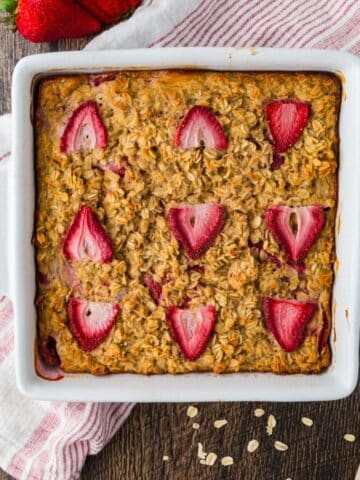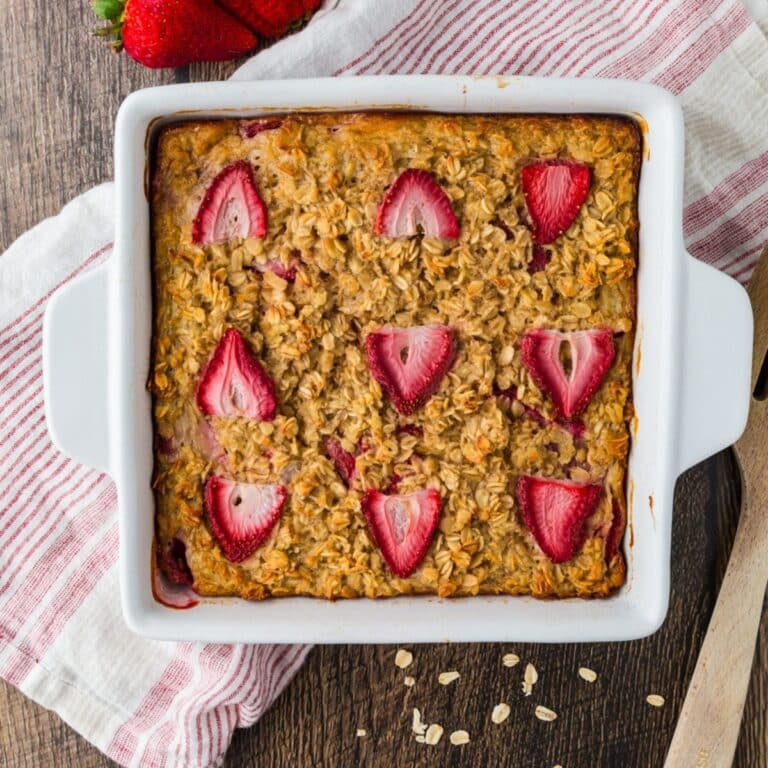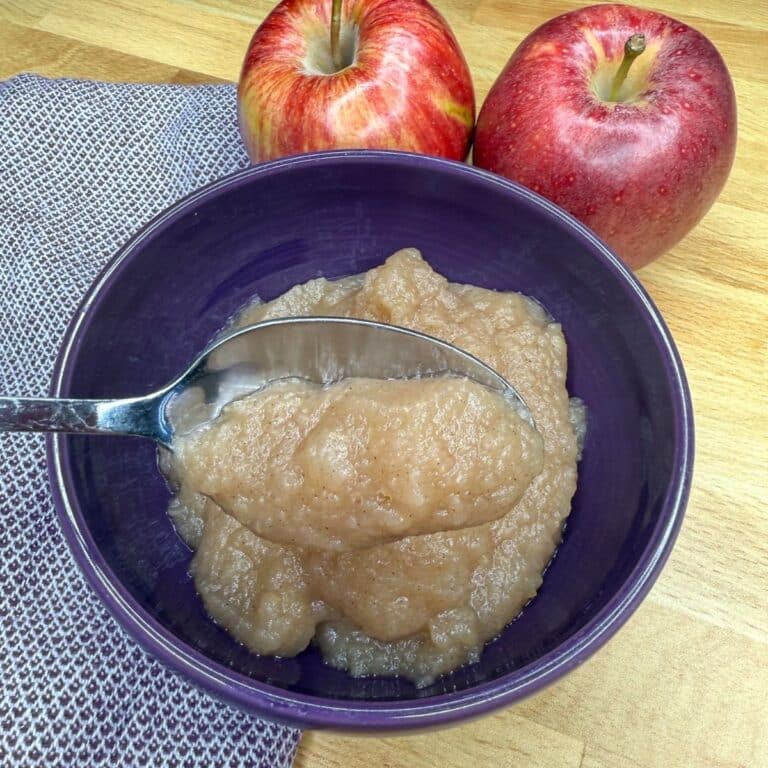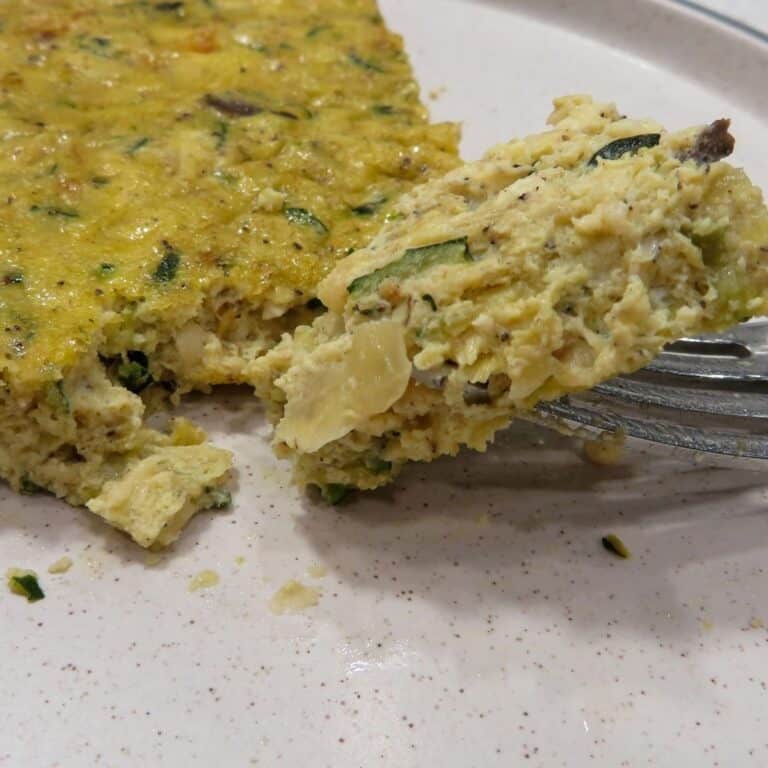Salmon Omelette
This Salmon Omelette is an excellent choice for individuals managing chronic kidney disease (CKD), offering a nutritious meal with careful consideration of protein and sodium content. Rich in omega-3 fatty acids from the salmon, this dish supports heart health, which is crucial for CKD patients.

The inclusion of low-phosphorus feta and the use of fresh herbs and spices reduce reliance on salt, making it a kidney-friendly option. The controlled portions of protein from both the eggs and salmon help manage protein intake, essential for those with CKD. Enjoy this savory and health-conscious recipe that doesn't compromise on flavor while adhering to dietary needs..
For More Recipes and Ideas --->> Get Your Free Meals and Recipes That Are Perfect for Pre-Dialysis Diets, Pre-Dialysis with Diabetes, or Dialysis Diets.
This was inspired by my low sodium frittata on this site. This recipe was included as part of our Mother's Day Brunch. We also served Dairy-Free Cinnamon Rolls, Strawberry Baked Oatmeal, and Pineapple Salad.
Jump to:
Ingredients For Salmon Omelet

- Eggs - Used as the base of the omelette, providing structure and flavor.
- Water - Added to the eggs to help make the omelette lighter and fluffier.
- Black pepper - Provides a mild heat and enhances the overall flavor of the dish.
- Butter - Used for cooking and to add richness and flavor to the omelette.
- Salmon - Adds a rich, fishy flavor and protein to the omelette.
- Feta cheese - Offers a tangy contrast to the mild eggs and complements the salmon.
- Red onion - Brings a slight crunch and sharpness, balancing the richer flavors.
- Fresh dill - Gives a burst of herby freshness that pairs well with salmon.
See recipe card for quantities.
How To Make A Salmon and Egg Omelet
Here is the step by step picture and guide for how to make a salmon omelet.
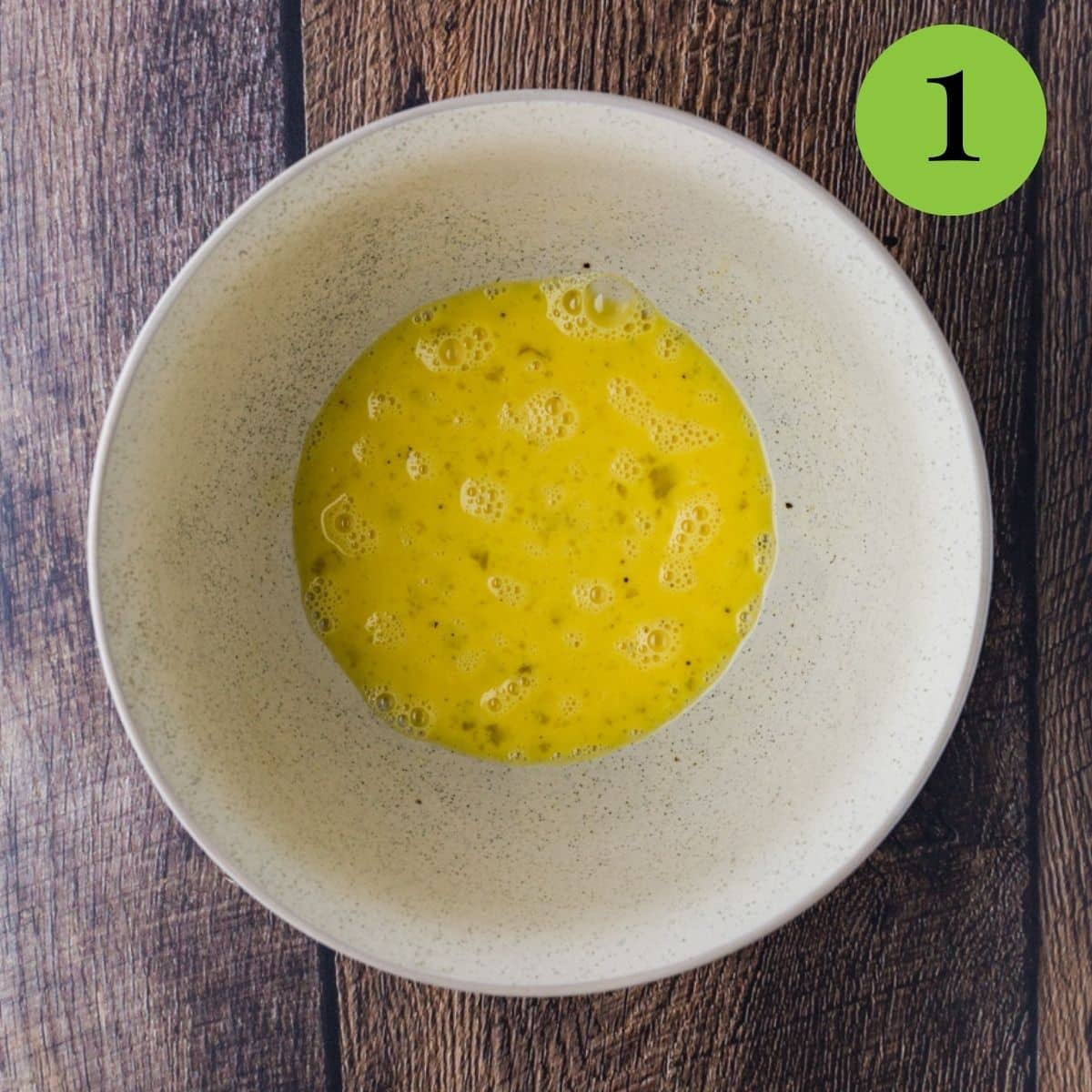
1. Whisk eggs, water and pepper in a bowl.

2. Melt butter in a non-stick skilled over medium-low heat and tilting the pan to ensure the entire pan is coated. Add onions and cook for 1 minute.

3. Add the egg mixture and cook for 1 minute without stirring.

4. Sprinkle the salmon, feta and dill over one half of the eggs. Cook for 1 minute.
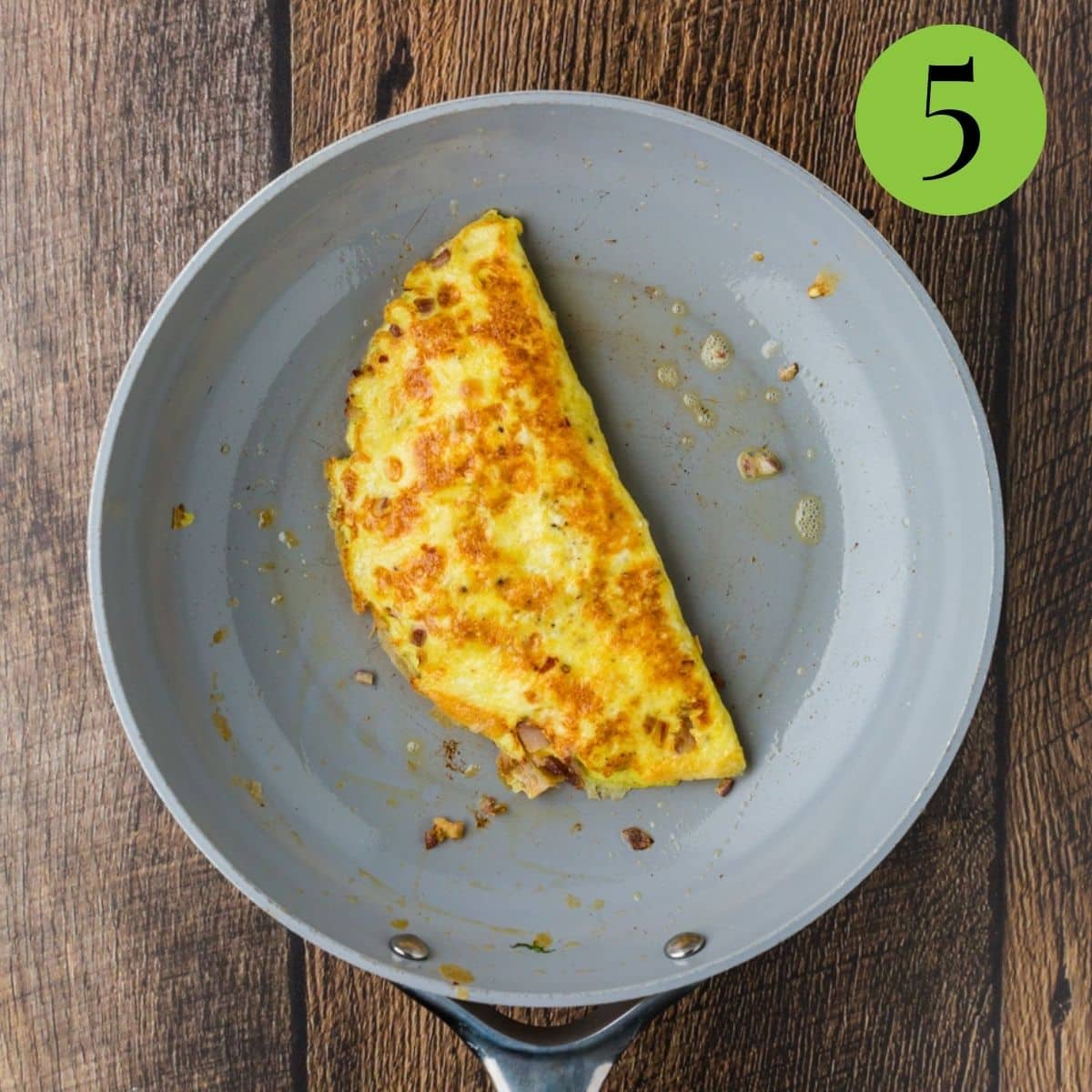
5. Using the spatula, flip the bare side over the filling, folding the omelette in half and cook for one more minute. Lower the heat if it's cooking too fast. Carefully flip the omelette over and cook 1 more minute. Serve immediately.

6. Serve on a plate with other dishes.
Hint: Be gentle when folding over the salmon omelet to avoid breaking it, allowing the delicate flavors of the salmon, feta, and herbs to meld beautifully without overwhelming the eggs.
Substitutions
Here are some options to swap out for a still yummy but also kidney friendly omelet.
- Swap Feta for Ricotta Cheese - If feta is too high in sodium, consider using ricotta cheese, which is typically lower in sodium and phosphorus, making it a gentler option for those with CKD.
- Use Egg Whites Instead of Whole Eggs - To reduce the phosphorus and fat content, you can use only egg whites instead of whole eggs. This is especially beneficial for CKD patients who need to monitor their cholesterol intake.
- Replace Red Onion with Green Onion - For a milder flavor and lower potassium content, swap red onion for green onion. Green onions provide a subtle taste without the sharper bite of red onions, which can be more suitable for sensitive palates and kidney health.
Variations on the Salmon Omelet
Here are three variations you can make to the omelette with salmon recipe while keeping it kidney-friendly:
- Add Vegetables - Incorporate kidney-friendly vegetables like bell peppers or zucchini for added flavor, texture, and nutrients without significantly impacting potassium levels. These vegetables can be sautéed lightly before adding to the omelette to bring out their natural sweetness.
- Use Different Herbs - Instead of dill, try using other fresh herbs such as parsley or chives. These herbs are low in potassium and can enhance the flavor of the omelette without adding sodium or other restricted elements for those with CKD.
- Swap Salmon for Tuna - If you want a variation in protein, canned tuna (in water) can be a good substitute for salmon. It's still rich in omega-3 fatty acids and provides a different flavor profile while remaining low in phosphorus and suitable for a renal diet.
Storage
Because this salmon omelette is a single serving and ready made, we recommend you don't store it. Only make what you want to eat and save the extra ingredients separately so that you can make it again later.

Top tip
The salmon package is typically 2.5 ounces, so you can make 2 omelettes with one package - either for two people at one sitting or store the extra salmon in the refrigerator and use it within 3 days.
FAQ about Salmon and Egg Omelets
What is the trick to a perfect omelette?
The trick to making a perfect omelette lies in several key steps:
- Whisk Well: Whisk the eggs thoroughly until they are completely blended and slightly frothy, which introduces air and makes the omelette fluffier.
- Use the Right Pan: A non-stick skillet is ideal because it prevents the eggs from sticking and makes it easier to flip or fold the omelette without tearing.
- Control the Heat: Cook the omelette on medium-low heat. A gentle heat allows the eggs to cook evenly without browning too quickly on the outside while remaining runny on the inside.
- Don’t Over-stir: Once you pour the eggs into the pan, let them set for a few seconds before you start pulling the edges into the center. This method helps create a light, tender texture.
- Be Patient with the Fillings: Add the fillings only after the bottom has set but the top is still slightly runny. This timing ensures that the fillings get heated through without overcooking the eggs.
Is water or milk better for an omelette?
For a kidney-friendly omelette, water is typically better than milk. Here’s why:
- Lightness and Fluffiness: Adding a small amount of water to the eggs before whisking can make the omelette lighter and fluffier. Water turns into steam as it heats, helping to create a soft and airy texture.
- Kidney Health Considerations: For those with kidney disease, controlling dairy intake is often recommended because milk contains higher levels of phosphorus and potassium compared to water. Using water avoids these extra minerals.
- Calorie Reduction: Using water instead of milk can also reduce the calorie content of the omelette, which may be beneficial for those managing their weight.
By focusing on these aspects, you can enhance both the healthiness and the culinary quality of your omelettes.
Related Breakfast Recipes
Looking for other recipes for your kidney friendly breakfast? Try these:
Our Latest Kidney Friendly Recipes
These are my favorite dishes that we've recently made:
If you tried this Recipe or any other recipe on my website, please please leave a star rating and let me know how it goes in the comments below. I love hearing from you!
Salmon Omelette
This salmon omelette, packed with nutritious omega-3s and flavored with feta and fresh herbs, offers an elegant and healthy option that's perfect for a special Mother's Day brunch.
- Prep Time: 2
- Cook Time: 10
- Total Time: 12 minutes
- Yield: 1 1x
- Category: Breakfast
- Method: Stove Top
- Cuisine: American
- Diet: Low Salt
Ingredients
2 eggs
1 tsp water
¼ tsp black pepper
1 tsp butter
1.25 ounce salmon in spring water, packet, drained
1 tbsp crumbled feta
1 tbsp chopped red onion
½ tsp fresh dill, chopped
Instructions
1. Whisk eggs, water and pepper in a bowl.
2. Melt butter in a non-stick skilled over medium-low heat and tilting the pan to ensure the entire pan is coated. Add onions and cook for 1 minute.
3. Add the egg mixture and cook for 1 minute without stirring.
4. Sprinkle the salmon, feta and dill over one half of the eggs. Cook for 1 minute.
5. Using a flexible spatula, lift the side of the omelette to let the raw egg from the middle flow underneath, you may need to tilt the pan slightly. Continue to do this in different spots until there's almost no raw egg on top. Cook for 2 more minutes.
6. Using the spatula, flip the bare side over the filling, folding the omelette in half and cook for one more minute. Lower the heat if it's cooking too fast. Carefully flip the omelette over and cook 1 more minute. Serve immediately.


